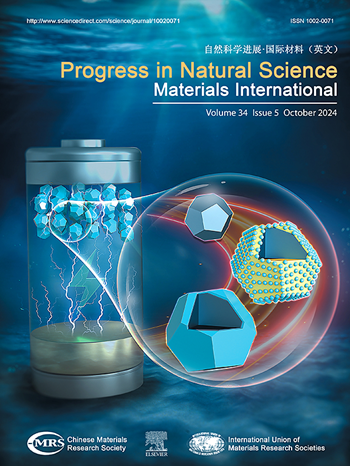Three-dimensional Graphene/MnO2 nanowires foam for photothermal-enhanced visible-light photocatalytic degradation of refractory organic pollutants
IF 7.1
2区 材料科学
Q2 MATERIALS SCIENCE, MULTIDISCIPLINARY
Progress in Natural Science: Materials International
Pub Date : 2025-02-01
DOI:10.1016/j.pnsc.2024.11.007
引用次数: 0
Abstract
With the rapid development of modern industry, stable organic dyes and antibiotics pollution in surface water have become emerging issues. In this study, a 3D reduced graphene oxide (rGO)/MnO2 nanowires foam (3D rGO/MnO2) has been developed, demonstrating excellent photothermal-enhanced visible-light photocatalytic activity for the degradation of refractory organics. The interconnected graphene network and disturbed MnO2 nanowires endow 3D rGO/MnO2 high UV–Vis–NIR absorption and favorable mechanical stability. The surface temperature can be increased to be about 82 °C under one sunlight, which will increase the carrier density, promote transport and enhance the carrier mobility to improve the photocatalytic performance. The photocatalytic degradation rate of Methylene blue (MB) is as high as 92 % (5 mg/L) and the degradation rate of tetracycline hydrochloride (TC) is 75 % (5 mg/L). Different from the traditional photocatalyst of dispersed state, this foam-like and mechanical stable 3D rGO/MnO2 could be moved from treated water to unpurified water treatment easily that could be favorable for the practical application.
三维石墨烯/二氧化锰纳米线泡沫光热增强可见光催化降解难降解有机污染物
随着现代工业的快速发展,地表水中稳定的有机染料和抗生素污染已成为人们关注的问题。在这项研究中,开发了一种3D还原氧化石墨烯(rGO)/MnO2纳米线泡沫(3D rGO/MnO2),显示出优异的光热增强可见光催化降解难降解有机物的活性。互连的石墨烯网络和扰动的MnO2纳米线赋予了3D rGO/MnO2高紫外-可见-近红外吸收和良好的机械稳定性。在一次光照下可将表面温度提高到82℃左右,从而增加载流子密度,促进运输,增强载流子迁移率,从而提高光催化性能。对亚甲基蓝(MB)的光催化降解率高达92% (5 mg/L),对盐酸四环素(TC)的光催化降解率高达75% (5 mg/L)。与传统分散状态的光催化剂不同,这种泡沫状、机械稳定的3D rGO/MnO2可以很容易地从处理过的水转移到未净化的水处理中,有利于实际应用。
本文章由计算机程序翻译,如有差异,请以英文原文为准。
求助全文
约1分钟内获得全文
求助全文
来源期刊
CiteScore
8.60
自引率
2.10%
发文量
2812
审稿时长
49 days
期刊介绍:
Progress in Natural Science: Materials International provides scientists and engineers throughout the world with a central vehicle for the exchange and dissemination of basic theoretical studies and applied research of advanced materials. The emphasis is placed on original research, both analytical and experimental, which is of permanent interest to engineers and scientists, covering all aspects of new materials and technologies, such as, energy and environmental materials; advanced structural materials; advanced transportation materials, functional and electronic materials; nano-scale and amorphous materials; health and biological materials; materials modeling and simulation; materials characterization; and so on. The latest research achievements and innovative papers in basic theoretical studies and applied research of material science will be carefully selected and promptly reported. Thus, the aim of this Journal is to serve the global materials science and technology community with the latest research findings.
As a service to readers, an international bibliography of recent publications in advanced materials is published bimonthly.

 求助内容:
求助内容: 应助结果提醒方式:
应助结果提醒方式:


